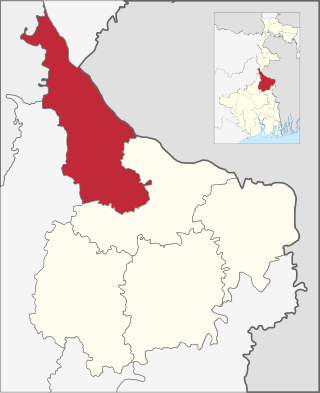Harharia Chak is a census town in the Raninagar I CD block of the Domkal subdivision in the Murshidabad district in the Indian state of West Bengal.
Nabagram is a village in the Nabagram CD block in the Lalbag subdivision of Murshidabad district in the Indian state of West Bengal.

Lalbag subdivision is an administrative subdivision of Murshidabad district in the state of West Bengal, India.

Jangipur subdivision is an administrative subdivision of Murshidabad district in the state of West Bengal, India.
Domkal is a town and headquarters of the Domkal Subdivision in Murshidabad district in the Indian state of West Bengal.
Bhagawangola is a growing town with a police station, not identified in 2011 census as a separate place, in the Bhagwangola I CD block in the Lalbag subdivision of Murshidabad district in the state of West Bengal, India.

Domkal is a community development block that forms an administrative division in the Domkol subdivision of Murshidabad district in the Indian state of West Bengal.

Jalangi is a village, with a police station, identified in 2011 census, in Jalangi CD Block in Domkol subdivision of Murshidabad district in the state of West Bengal, India. The village is situated along the bank of the Padma River.

Raninagar I is a community development block that forms an administrative division in Domkol subdivision of Murshidabad district in the Indian state of West Bengal.

Islampur is a census town in the Raninagar I CD block in the sri chaitanya techno panihati of the Murshidabad district in the state of West Bengal, Indi
Sagarpara is a village and gram panchayat in the Jalangi CD block in the Domkol subdivision of Murshidabad district in West Bengal, India. It is 2.5 kilometres from the Padma River.
Ranitala is a village, with a police station, in the Bhagawangola II CD block in the Lalbag subdivision of Murshidabad district in the state of West Bengal, India.
Nasipur is a village in the Bhagawangola II CD block in the Lalbag subdivision of Murshidabad district in the state of West Bengal, India.
Raninagar is a town with a police station, not identified in 2011 census as a separate town, in the Raninagar II CD block in the Domkol subdivision of Murshidabad district in the state of West Bengal, India.
Kasbagoas is a village in the Raninagar I CD block in the Domkol subdivision of Murshidabad district in the state of West Bengal, India.
Shaikhpara is a town, with a college, not identified in 2011 census as a separate place, in the Raninagar II CD block in the Domkol subdivision of Murshidabad district in the state of West Bengal, India. It is possibly part of Babaltali village in the census records. Babaltali is a big village with a population of 20,177 in 2011.
Kismattatla is a village in the Bhagawangola I CD block in the Lalbag subdivision of Murshidabad district in the state of West Bengal, India.
Krishnapur is a village in the Lalgola CD block in the Lalbag subdivision of Murshidabad district in the state of West Bengal, India.
Sadikhanr Diar is a village in the Jalangi CD block in the Domkal subdivision of Murshidabad district in the state of West Bengal, India.
Bhagirathpur is a village and a gram panchayat in the Domkal CD block in the Domkol subdivision of Murshidabad district in the state of West Bengal, India.











